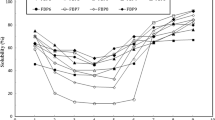Abstract
Soy lecithins are important emulsifiers used in the food, feed, pharmaceutical, and technical industries. Native lecithin is derived from soybean oil in four steps: hydration of phosphatides, separation of the sludge, drying, and cooling. Such lecithin has both W/O and O/W emulsifying properties. Products with improved emulsifying properties can be obtained by modifications, involving mainly fractionation in alcohol, hydrolysis (enzymatic, acid, or alkali), acetylation, or hydroxylation. Careful processing is required to produce lecithins of a high chemical, physical, and bacteriological quality.
Similar content being viewed by others
Author information
Authors and Affiliations
About this article
Cite this article
Van Nieuwenhuyzen, W. Lecithin production and properties. J Am Oil Chem Soc 53, 425–427 (1976). https://doi.org/10.1007/BF02605737
Issue Date:
DOI: https://doi.org/10.1007/BF02605737




